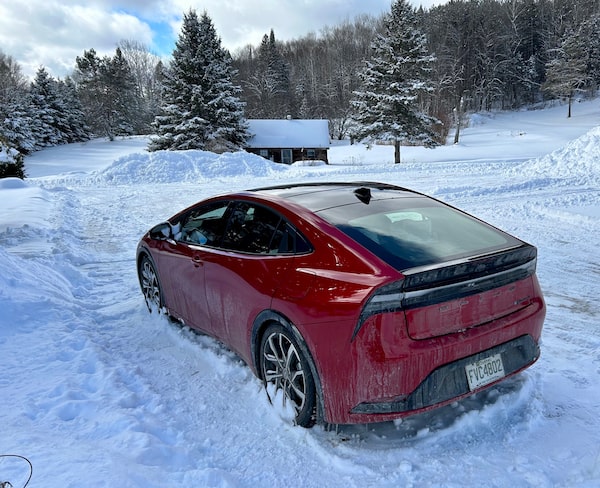
The Toyota Prius Prime on a winter camping trip in Algonquin Provincial Park, Ont.Jeremy Sinek/The Globe and Mail
Her dream is to go winter yurt camping in Algonquin Provincial Park in Ontario. I’m interested in buying a Toyota Prius Prime for our next new car. But she worries the Prius won’t have enough cargo space for camping or cottage trips. So I suggest we borrow a press vehicle to find out.
The Prime is the plug-in version of Toyota’s redesigned Prius, its conventional hybrid electric vehicle. Most people these days buy SUVs, but I prefer an actual car, and the sleek, swoopy Prius is unequivocally a car. One downside, however, is that it has less cargo space than even its predecessor, and much less than the gas-engined Volkswagen Golf SportWagen we drive now.
The Golf is quite the fuel miser on long trips (better than six litres per 100 kilometres) but it’s getting old. We want our next car to be electrified, but nobody makes an affordable battery-electric car (let alone a wagon) that checks our boxes. Enter the reformed Prius with its deft handling (check), solid acceleration (check), hatchback versatility (check) and up to 72 kilometres of electric range (check) before the gas engine kicks in.
Our mid-February trip to the near North wasn’t going to be for long, and having booked a yurt for the first two nights, we didn’t need a tent. Still, we had a lot to take: a 20-litre water jug, food and clothing for four days, sleeping bags and pillows, heavy winter coats and boots, cooking and eating equipment, picnic chairs, skates, snowshoes, a camera, laptop and an iPad. There might have been a bottle or two of wine and beer, too.
It all went in. With the rear seats folded flat, and using the rear footwell space, our chattels even fit below the window lines. So far, so good.
Our Prius loaner was the top trim XSE Premium, but if we buy a Prime, I want the base SE. The pricier trims’ bigger tires and added weight suck energy. While the SE claims 72 kilometres of electric range, and gas-only fuel consumption of 4.5 litres per 100 kilometres, the other trims rate 64 kilometres and 4.9 litres, respectively.
Those are the official numbers, though we never saw more than 59 kilometres of projected range when starting on a full charge – and that was with the heater off. That said, our first three days and 115 kilometres driving around our home in the Greater Toronto Area – in unseasonably mild weather – were entirely electric and actual EV range panned out at 60 to 65 kilometres. Power consumption averaged 17.3 kilowatt-hours per 100 kilometres.
The shortest-lived charge was on the drive to Algonquin. The net-uphill highway run drained the battery after 42 kilometres of 100-per-cent electric driving. After completing the remaining 260 or so kilometres in Hybrid mode, the trip computer showed a stingy 3.6 litres per 100 kilometres.
Camping with a PHEV is potentially a two-way street. The Prime has a 1,500-watt, 120-volt outlet that can power devices or camping equipment when off-grid, assuming you ensure the battery has enough charge (the Prius has a charge-while-driving mode). We, however, had an electrified site, so my goal was to recharge overnight for maximum electrified driving when driving to trailheads in Algonquin’s pristine wilderness.
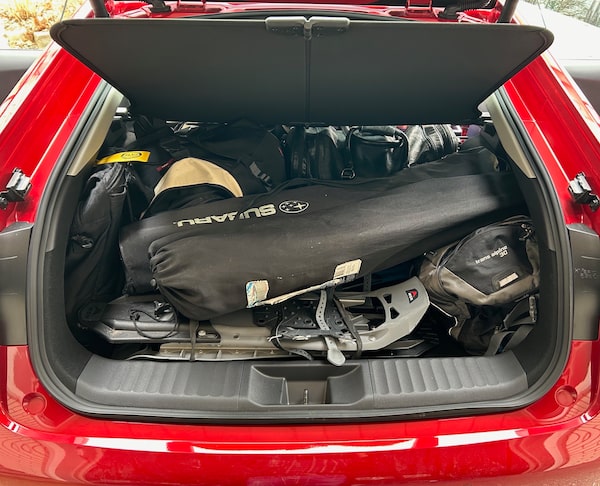
With the back seats folded down, all of our stuff fit in the Prius Prime.Jeremy Sinek/The Globe and Mail
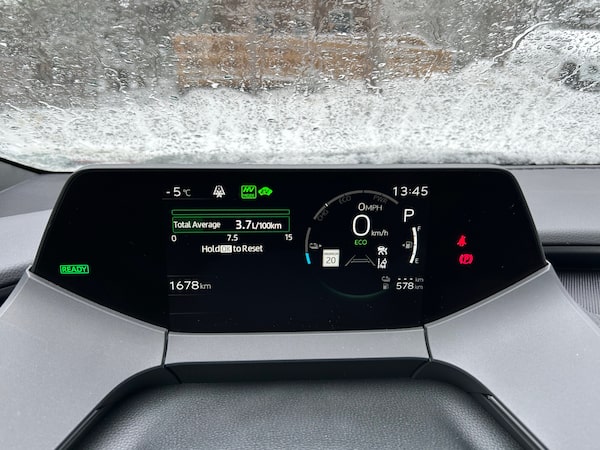
The SE trim claims 72 kilometres of electric range and gas-only fuel consumption of 4.5 litres per 100 kilometres.Jeremy Sinek/The Globe and Mail
Well, that didn’t quite go according to plan: Our site’s 15/30-amp power pedestal was beyond the reach of the Prius’s charging cable. And the owner’s manual forbids using an extension cable.
A chat with the campground host turned up an empty site with an easily accessible pedestal. However, it was a few minutes’ walk from our site, and its proximity to the comfort station conjured visions of bleary-eyed, full-bladdered campers stumbling past in the middle of the night. After a few hours, with 25 kilometres of range recouped, I brought the Prius back “home” at bedtime.
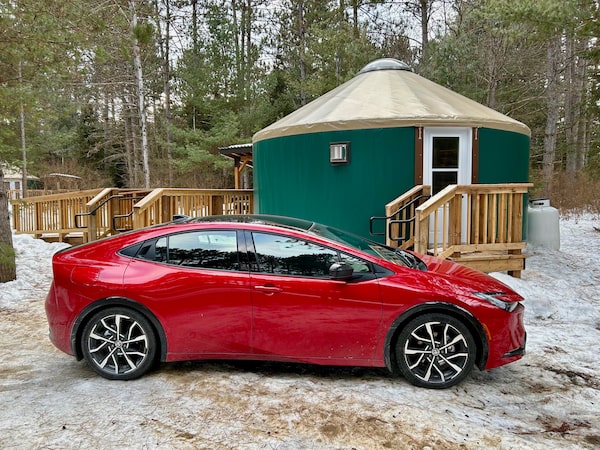
The Prius Prime parked outside our yurt.Jeremy Sinek/The Globe and Mail
Next morning’s mission was to evaluate heating and defogging in EV mode. Driving to the trailhead at a relatively mild minus 5 degrees, the results were random. The climate control worked well (we needed it more for defogging than cabin warmth) when the car was in EV mode.
That night, I opted not to charge at the “borrowed” site. There was 15 centimetres of snow in the forecast, and the power pedestal’s weatherproofing looked iffy. Hence the next day’s 80-kilometre drive was hybrid all the way to our friends’ place near Maynooth, just outside the park. When we plugged in there, cumulative gas consumption had edged up to 4.1 litres per 100 kilometres.
Driving back to drop the car off in Toronto two days later, we started in EV mode with 58 kilometres of electric range showing. Again, the car defied our “maximized-electrified” mission, and occasionally fired up the engine. Thus EV mode “officially” lasted 63 kilometres.
Over all, we drove the Prime 794 kilometres – 114 on home ground, and 680 on the winter road trip. With a PHEV, the option to recharge on a road trip is nice, but not necessary. Yet despite some missed recharging opportunities, we logged about 240 kilometres in EV mode. Temperatures on the road trip ranged between minus 10 and zero, and gas consumption for the whole week averaged 4.1 litres per 100 kilometres.
I already knew I enjoyed driving the new Prius, and the eco-cheapskate in me was sold on its combination of energy efficiency and range serenity. Now we know it can handle our practical needs, too. Will we buy one? We can’t right now – last we heard, they’re back-ordered for 12 to 18 months. But unless another PHEV comes to market in the meantime shaped like a compact station wagon, a Prius Prime is likely to be our next car.
Tech specs
2024 Toyota Prius Prime XSE Premium
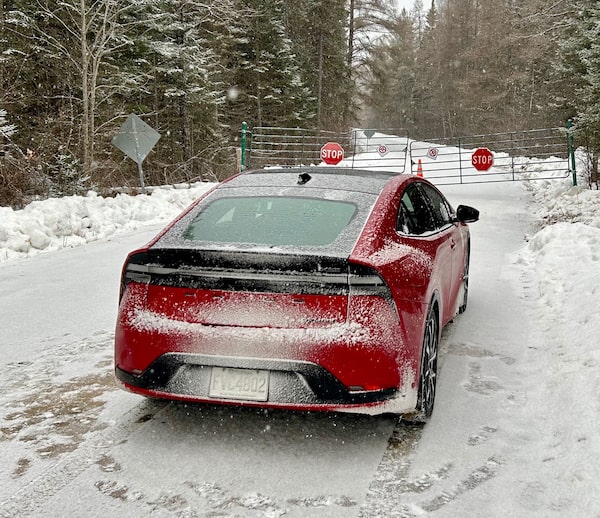
Jeremy Sinek/The Globe and Mail
- Base price/as tested: $48,050/$48,305 (plus $1,860 for freight, less $5,000 ZEV rebate)
- Powertrain: Two-litre gasoline four-cylinder/dual-motor hybrid
- Transmission/drive: Continuously variable automatic/front-wheel drive
- Fuel consumption (per 100 kilometres): 4.7 city/5.0 highway (litres gasoline); 18.3 kilowatt-hours combined (electric)
- Alternatives: There are no other PHEV passenger cars in a comparable price range